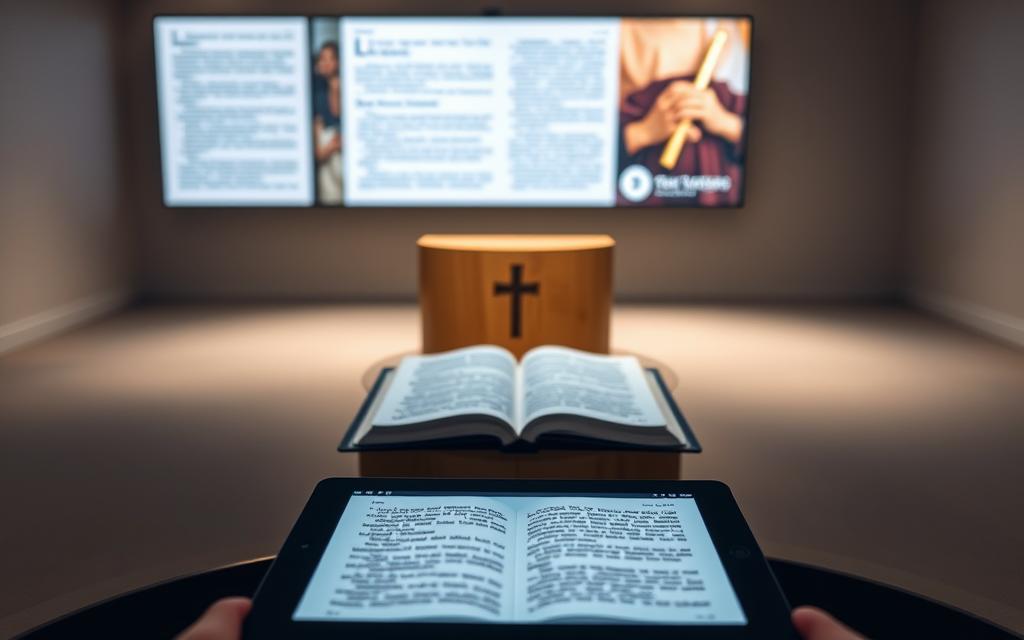Traditional religious beliefs are declining in Western societies. Fewer people now identify with established faiths than before.
This doesn’t mean faith has disappeared. Instead, we see a religious faith evolution through digital means. Smartphones and social media are new places for exploring spirituality.
Sister Ilia Delio notes that faith is changing, not disappearing. The mix of technology and religion leads to new ways of believing. Now, artificial intelligence is used in roles like robotic priests and digital confessionals.
This blend of digital age faith and modern tools changes how we practice and experience spirituality. The world of belief is constantly evolving.
The Digital Transformation of Religious Practices
Religious practices are changing fast with digital technology. This change is not just about being more convenient. It’s changing how we join in and build communities today.
From Physical Congregations to Virtual Communities
Now, we have virtual religious communities that go beyond where we live. Social media like Instagram, TikTok, and Facebook help us share our faith. They connect us in ways we never thought possible.
People like ShanDien Sonwai LaRance and Melinda Strauss have lots of followers. They share faith-based content online. This lets us stay connected all the time, not just on Sundays.
Online communities have many benefits:
- They’re always open for spiritual content and talks.
- They connect people from all over the world.
- They’re great for those who can’t get to church easily.
- They offer views from different cultures.
Streaming Services and Digital Worship Experiences
Online worship services are making it easier to join in. Churches and mosques are streaming their services online. This lets people join in from anywhere with internet.
This digital way of worship is really helpful when we can’t meet in person. Many places say more people are joining online than in person.
Online services often have live chats and ways to give money. These features make us feel like we’re part of it, even if we’re far away.
Mobile Applications for Prayer and Meditation
Smartphones have changed how we pray and meditate with prayer apps and guides. These apps help us keep up with our faith, even when we’re busy.
Apps alert us to prayer times and offer daily devotionals. Some even help us find halal or kosher food. This shows how faith can be part of our daily lives.
Meditation apps often have spiritual content too. This mix of old and new ways of practicing shows a big change in how we think about spirituality.
| Aspect of Practice | Traditional Approach | Digital Transformation | Key Benefits |
|---|---|---|---|
| Community Gathering | Physical attendance at designated locations | Virtual participation through social platforms | Global access, flexible timing |
| Worship Services | In-person ceremonies and rituals | Livestreamed and recorded services | Accessibility, reviewability |
| Personal Devotion | Scheduled prayer times, physical texts | Mobile app reminders, digital resources | Consistency, portability |
| Religious Education | Formal classes, printed materials | Digital libraries, online courses | Comprehensive resources, self-paced learning |
The digital change in religious practices is ongoing. It brings new chances and challenges for faith groups around the world. This change is one of the biggest in recent history.
How Does Technology Affect Religious Education and Scripture Access
Technology has changed how we learn about faith and access sacred texts. It has opened up new ways to learn about religion. Now, people can learn about their faith at their own pace, whenever they want.
Digital Libraries and Online Religious Resources
Digital libraries have made religious knowledge more accessible. Anyone with internet can now read sacred texts and scholarly works. Websites like Google Books and religious databases offer instant access to scriptures.
This digital scripture access is like the impact of the printing press. It has removed barriers to religious education. People can now compare translations and access commentary from different traditions.

Social Media as a Platform for Religious Discourse
Social media has become a place for social media faith discourse. It allows believers and seekers to discuss theology. Facebook groups, Twitter threads, and Instagram communities host conversations about scripture and spiritual practices.
These digital spaces let people from all over the world join in religious discussions. But, there are challenges like misinformation and the need to be careful about what we read online.
Virtual Religious Education Programmes
Religious institutions worldwide are using online religious education. They offer courses and degrees online. This includes everything from basic scripture courses to advanced theological degrees.
These programmes are flexible for students who can’t attend classes in person. They combine online learning with live sessions. This way, students get a good balance of learning and community.
Even though digital education is convenient, educators are looking for ways to keep the community feeling. The future might see a mix of online learning and personal connection.
Technology’s Impact on Religious Community Building
Digital platforms have changed how religious groups connect across the world. This change helps build lasting networks that support believers everywhere.
Global Connections Through Digital Platforms
Technology lets people from isolated areas or minority faiths find community online. Digital spaces let them share and get spiritual support, no matter where they are.
Social media groups, religious apps, and video calls help keep communities close. These global religious networks are key for those practicing alone.
The Role of Technology in Interfaith Dialogue
Interfaith technology is a powerful tool for understanding different religions. Digital platforms offer neutral spaces for meaningful talks, free from location limits.
Online Interfaith Forums and Discussions
Virtual forums let people from various backgrounds talk about their beliefs. These talks can build empathy and clear up misunderstandings between faiths.
Video conferences and text platforms make it safe to ask questions and share views. This digital community building across faiths is a big step forward.
Digital Tools for Comparative Religious Studies
Educational tech gives us new ways to learn about religions. Databases, timelines, and multimedia help us see how different beliefs relate.
The table below shows some popular tools for studying religions:
| Tool Type | Primary Function | Key Features | Accessibility |
|---|---|---|---|
| Religious Databases | Scripture comparison | Multiple translations, search functionality | Free and subscription models |
| Interactive Timelines | Historical context | Visual representations, linked resources | Mostly free access |
| Virtual Museum Tours | Cultural understanding | 3D artefacts, expert commentary | Free with internet access |
| Mobile Applications | Daily learning | Push notifications, community features | Freemium model common |
These tools are great, but we must be aware of their limits. The digital format can simplify complex ideas. We need to navigate the information carefully to avoid shallow understanding.
Technology’s role in building religious communities is always changing. It offers chances for deeper connections but also brings challenges that need careful thought.
Challenges and Ethical Considerations in Digital Religion
Digital platforms have opened up new ways for people to connect with their faith. Yet, they also bring up big ethical questions. Issues like privacy, who can join in, and keeping content true to faith are key concerns for religious groups.

Privacy Concerns in Digital Religious Spaces
Many apps and websites for faith collect personal info. This includes what people pray for, their beliefs, and how often they join in. This makes some people worry about their privacy, even in what they think are safe places.
Keeping this personal data safe is a big worry in digital religion ethics. Churches and faith groups need to protect this info well. They must stop it from being shared without permission or used for money.
The Digital Divide and Religious Accessibility
Not everyone can use technology the same way. Some, like older people or those with less money, might struggle to get online. This makes it hard for them to join in with digital religious activities.
This problem creates a new kind of exclusion. People without good internet or modern devices can’t join online prayers or read digital scriptures. Churches need to find ways to include everyone, not just those with technology.
Authenticity and Authority in Online Religious Content
The internet lets anyone share religious teachings. This freedom makes it hard for people to know what’s real and what’s not. It’s a big challenge for those looking for true faith.
When people look for spiritual guidance online, it’s key to know if it’s real. Without ways to check, followers might follow teachings that don’t match their faith’s true teachings.
Churches are working on ways to show if content is approved. They’re creating systems and tools to help people find trusted teachings. This helps keep faith true while using new technology.
The Rome Call for AI Ethics gives important advice on these issues. As tech keeps changing, it’s a constant challenge for faith groups to stay true to their values and adapt to new ways.
Conclusion
Technology has changed how we practice religion, bringing both good and bad. It makes it easier to join in worship, learn, and connect with others. But, it also makes us wonder about the realness of things, our privacy, and who gets left behind.
The future of digital religion looks promising if we adapt wisely. We need to pick the right tech to help our faith grow. At the same time, we must keep our traditions alive.
Finding the right mix of tech and faith is key. As research shows, only 17% of UK folks trust religious groups. This shows we need to be real online to gain trust.
Belief is a basic human need. Tech is just a tool, not a replacement for true spiritual connection. The digital world challenges us to grow while keeping our values strong. This way, faith can thrive in our connected world.







